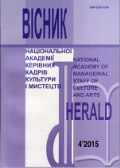ENSEMBLE AND PERFORMANCE TASKS OF DANCE IMAGE INTERPRETATION IN THE INSTRUMENTAL MUSIC
DOI:
https://doi.org/10.32461/2226-3209.4.2015.138437Keywords:
dance image, rhythm, movement, performer’s interpretation, suiteAbstract
In the article there is considered and determined a number of ensemble and performance tasks aimed at the dance image interpretation. On the example of the suites for a two-clavier duo by M. Skoryk, Zh. Kolodub, A. Casella, E. Chabrier and other composers there is revealed the meaning of musical and instrumental expressive means (tempo and rhythmic organization, agogic character, performance dynamics) in the implementation of dance idea. It is suggested to consider the notion of the "modus of performer’s dancingness" as a peculiar performer’s state during retranslation of the dance image by the pianists’ ensemble.
Necessity and actuality of this research is ensured by numerous references to piano duo works, whose artistic structure suggests interpretation of the dancing semantics, in teaching and pedagogic process as well as in the concert practice. Instrumental performance of dancing music and choreographic implementation of the dance unites temporal and procedural factors. With the external resemblance of many parameters of organizational and expressive means (performance tempo, slowing down or acceleration of movement, accents, caesura etc.) pianists should take into consideration specifics of expressive means introduced by the composer in the music scores for individual realization of a dance idea.
The purpose of the article is to identify specifics of ensemble and performers’ tasks on the way towards interpretation of the dance image. Consideration of several important components facilitating interpretation in the projection on music and dance performance will help to efficiently realize potential of dancingness in the instrumental piece. Based on the above mentioned goal, the following tasks are considered in the research: 1) manifestation of communicative ties between the dance images and piano expressive means; 2) analysis of the main manifestations of dance semantics in the piano duo pieces.
Manifestations of rhythm and tempo, of accelerations and slowing down, of plastics and amplitude of movements can be observed in the performance kinetics of a two-clavier duo while interpreting the music text of the suite of the dance type. It is not possible to perceive dance music without a comprehensive mastery interpretation of metric nature and rhythmic organization, which are connected with experiencing music motion.
The tasks, which a two-clavier duo constantly faces in the works of a dance character, are retaining precise rhythmic energy in a stable way, creating a plastic relief of the piece architectonics and building advanced rhythmic constructions. The ability to get soaked with a meter and rhythmic energy of the dance, to accumulate its emotional and motion potential and to convey it to the recipient-listener through the act of artistic interpretation during the concert performance are important elements of a peculiar state of performers, which we can be called a modus of performance dancingness. This notion signifies a peculiar psycho-emotional and physical state of the musician, promoting efficient production and retranslating performer’s dance image. Performance experience of the author of this research gives grounds to consider creation of synergy of rhythmic ideas of piano duo members while working on the suites of a dancing type as one of the most actual tasks. Solutions for these tasks should be based on building a common vision of the image potential of each separate source, on which dance semantics of the piece is based. When playing in a duo the pianists need to combine continual hearing control during their performance with the previous discussion of the plan of interpretation during rehearsals in order to reach synchronization of tempo changes.
Complex consideration of approaches towards estimation of the use of music means helps to reveal determining trends on the way towards solving the issues of effective realization of dancing content in the duo interpretation. Combination of clarity of performers’ ideas on the means found in the composer’s dance image with practical retranslation of motion and plastics content lays basis for success of interpreter’s activity. Understanding of the whole complex of musical and expressive manifestations of dancingness, of its links with characteristics of choreographic dancing plastics helps to achieve a live personal feedback of the participants of the two-clavier duo while performing suites. Interconnection of certain music means and kinetic information dance flow, which is clearly expressed in the instrumental piece, create preconditions for a positive result in the work of the duo members on the implementation of dancing semantics.
Downloads
Published
Issue
Section
License
Authors who publish with this journal agree to the following terms:
1. Authors retain copyright and grant the journal right of first publication with the work simultaneously licensed under a Creative Commons Attribution License that allows others to share the work with an acknowledgement of the work's authorship and initial publication in this journal.
2. Authors are able to enter into separate, additional contractual arrangements for the non-exclusive distribution of the journal's published version of the work (e.g., post it to an institutional repository or publish it in a book), with an acknowledgement of its initial publication in this journal.
3. Authors are permitted and encouraged to post their work online (e.g., in institutional repositories or on their website) prior to and during the submission process, as it can lead to productive exchanges, as well as earlier and greater citation of published work (See The Effect of Open Access).


